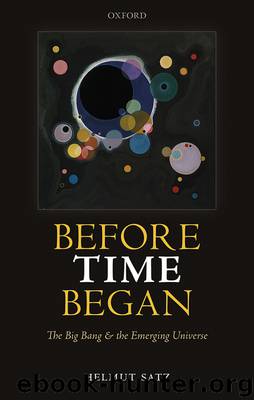Before Time Began by Helmut Satz

Author:Helmut Satz
Language: eng
Format: epub
Publisher: Oxford University Press
Published: 2017-09-11T14:39:00+00:00
The stages of the universe from the Big Bang to the formation of atoms; in the blue region the physical vacuum already exists
In this picture, we only show the succession of steps as they occurred in the evolution of the early universe. But it is of course also of interest to learn when what happened, at what “time after the Big Bang,” and what the state of the universe was at that time, “how hot” it was. The answers to these question obviously become less and less certain the further back we go. We try it anyway, and we begin with the time line.
As we have mentioned several times, the present atomic universe was born some 380,000 years after the Big Bang; that was when electrically charged nuclei and electrons combined to form neutral atoms. Before this time, there was the radiation era in which unbound nuclei and electrons together with photons and neutrinos were the essential constituents. This era had started some ten seconds after the Big Bang, because at that time most electrons and positrons had annihilated each other, turning into radiation, except for those electrons needed for today’s world. The hadron era before this had ended about one second after the Big Bang, when nucleons and antinucleons suffered this fate, annihilating each other except for what is left today, the rest becoming radiation. A large part of today’s photons was thus born in these two transitions, nucleon-antinucleon and electron-positron annihilation. The hadron era itself began in a genuine transition, 10−5 seconds after the Big Bang, when the density of the universe had dropped to a point at which the required quark density risked falling below that needed to assure each quark its partner. Quarks and antiquarks now were forced to combine to hadrons and/or antihadrons.
This transition, as mentioned, is the first that is quite well understood both theoretically and experimentally, through calculations based on quantum chromodynamics (the theory of strong nuclear interactions) and though experiments studying high-energy nucleus-nucleus collisions.
Before this, we have the Higgs transitions, which gave quarks and leptons their small intrinsic mass and the weak bosons their large ones. The determination of the mass of the Higgs boson in experiments at CERN has also here provided an empirical basis.
Download
This site does not store any files on its server. We only index and link to content provided by other sites. Please contact the content providers to delete copyright contents if any and email us, we'll remove relevant links or contents immediately.
| Aeronautics & Astronautics | Astronomy |
| Astrophysics & Space Science | Comets, Meteors & Asteroids |
| Cosmology | Mars |
| Solar System | Star-Gazing |
| Telescopes | UFOs |
Tools of Titans by Timothy Ferriss(8217)
Turbulence by E. J. Noyes(7935)
Secrets of Antigravity Propulsion: Tesla, UFOs, and Classified Aerospace Technology by Ph.D. Paul A. Laviolette(5309)
Astrophysics for People in a Hurry by Neil DeGrasse Tyson(5130)
Room 212 by Kate Stewart(5035)
Design of Trajectory Optimization Approach for Space Maneuver Vehicle Skip Entry Problems by Runqi Chai & Al Savvaris & Antonios Tsourdos & Senchun Chai(5011)
Pale Blue Dot by Carl Sagan(4912)
The David Icke Guide to the Global Conspiracy (and how to end it) by David Icke(4624)
A Journey Through Divination and Astronomy by Publishing Pottermore(4344)
Goodbye Paradise(3726)
Apollo 8 by Jeffrey Kluger(3637)
COSMOS by Carl Sagan(3554)
Losing the Nobel Prize by Brian Keating(3498)
The Five People You Meet in Heaven by Mitch Albom(3474)
How to Read Water: Clues and Patterns from Puddles to the Sea (Natural Navigation) by Tristan Gooley(3406)
Brief Answers to the Big Questions by Stephen Hawking(3369)
How to Read Nature by Tristan Gooley(3249)
The Order of Time by Carlo Rovelli(3145)
A Brief History of Time by Stephen Hawking(2960)
